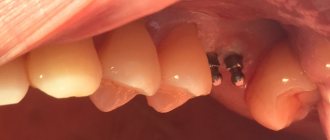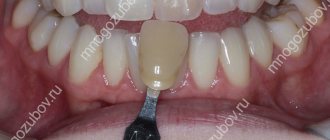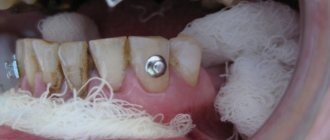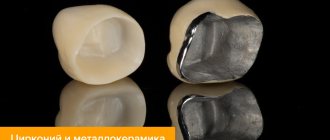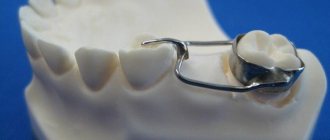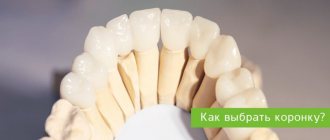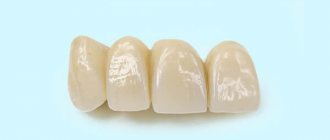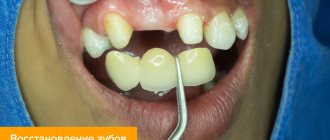The Maryland adhesive bridge is an orthopedic structure made of fiberglass and composite materials on a metal frame. Thanks to the special design of this prosthesis, it is possible to replace existing defects while preserving the supporting teeth as much as possible.
Adhesive prosthetics is based on gluing technology, and if in a conventional bridge structure the supporting elements are crowns placed on ground teeth, then in the Maryland bridge they are made in the form of overlays, claws or petals. The supporting teeth are not ground down; only small ledges are made in them, on which the prosthesis is attached.
Adhesive bridges are made by direct and indirect methods. In the first case, they are made by an orthopedic dentist directly in the patient’s mouth; in the second, by a dental technician, using individual casts of the jaws.
How to put a bridge on teeth -
Installing a bridge on teeth is carried out as follows... The teeth located on the sides of the missing one will act as support for the bridge. If only 1 tooth is missing, crowns are usually taken on one tooth on each side of the missing one. If 2 teeth are missing in a row, then a total of at least 3 teeth are taken under the bridge supports (one on one side of the dentition defect, and two on the other).
How to put a bridge on teeth: diagram and photo
Installing a bridge requires grinding down the supporting teeth for crowns, and here it must be taken into account that for different types of artificial crowns the thickness of the preparation will differ. For metal-ceramics, teeth are ground from the chewing surface by 2.0-2.5 mm, from the lateral surfaces by 1.5 mm (Fig. 4). For crowns made of metal-free ceramics - only 1.5 and 1.0 mm, respectively (Fig. 5). Moreover, the more tooth tissue is preserved under the artificial crown, the longer its service life will be.
Schemes for preparing teeth for crowns –
Moreover, please note that in the gingival zone, the tooth crown is ground in such a way that a so-called “ledge” (i.e., a step, Fig. 6) is formed along the entire perimeter of the tooth stump. The service life of the crown will largely depend on the quality of the ledge formation, because poor/inaccurate fit of the crown to the neck of the tooth in the area of the ledge - leads to the gradual entry of bacteria under the crown and the beginning of decay of the tooth tissue. And this happens very often.
Preparation of supporting teeth for prosthetics –
In many cases, teeth under artificial crowns are subject to depulpation, i.e. the nerve will need to be removed. This is due to the fact that deep in the tooth there is a neurovascular bundle (pulp), and the more tissue is ground off when preparing a tooth for a crown, the higher the risk of nerve injury. Accordingly, because Under metal-ceramics, more tooth tissue is ground off - here it is possible to leave mainly only large molars alive (they have a greater thickness of hard tissue around the nerve).
But for ceramic crowns, almost 2 times less tooth tissue is ground off, and in this case, almost all the teeth can be left alive. Keeping your teeth alive is very important because... after removal of the neurovascular bundle, the tooth stops receiving moisture and nutrition from the inside, which leads to an increase in the fragility of the hard tissues of the tooth and reduces its service life. The cost of removing nerves and filling root canals will depend on the number of root canals in the supporting teeth, and on average will be (for 1 tooth) –
- tooth with 1 root canal – from 2500 rubles,
- tooth with 2 channels – from 3800 rubles,
- tooth with 3 channels – from 5,000 rubles.
Dental bridge: before and after photos
Important: if the adjacent teeth from the missing one do not have fillings and are alive, then prosthetics with a bridge and grinding down the adjacent teeth for crowns is actually a very bad idea. The price of a dental bridge of 3 units made of ceramics or good metal-ceramics (taking into account the cost of preparing teeth for prosthetics) is almost always higher - when compared with the cost of installing 1 economy-class implant.
A dental bridge should be done only if the adjacent teeth from the missing one have large fillings (taking up more than 1/2 of the tooth crown in volume), and also if the nerves have been removed from them. Remember that the service life of the best crowns will be, at best, no more than 10-15 years, and what will happen to the supporting teeth after this time, and whether they can be re-used with prosthetics is still a big question. Your own living teeth (as opposed to artificial crowns) can last you much longer.
Important tips for caring for implants
The service life of implants directly depends on how they are cared for and monitored. It is recommended to treat implants carefully and with care. You need to be especially careful in the postoperative period; it is during this period that the mucous layer is greatly weakened, so it requires increased care. During this period, the following care rules should be observed:
- In the first period, you need to rinse your mouth;
- It is imperative to constantly maintain oral hygiene;
- It is necessary to properly clean the surface of teeth and implants from plaque;
- To remove food debris and plaque from hard-to-reach places, you need to use brushes, dental floss, and irrigators.
If all necessary rules are followed, it will help to avoid serious problems of premature wear of implants.
A dental brush is a device designed for super-effective mechanical removal of solid food debris, plaque from interdental spaces and hard-to-reach places.
Dental bridge: what material is best to choose from?
If we are talking about prosthetics of the front teeth, then according to statistics, most patients are dissatisfied with the bridges made for them.
As we said above, it is very difficult to make artificial crowns similar in color and transparency to neighboring teeth and, of course, good aesthetics today can be achieved mainly only by using metal-free ceramics - 1) Emax glass ceramics, 2) zirconium dioxide. But we also don’t forget about metal-ceramics, although there is one problem with it when prosthetizing the front teeth. Modern metal-ceramics in some cases can look almost as aesthetically pleasing as metal-free ceramics, but for this it is necessary - 1) to use expensive ceramic masses, 2) metal-ceramics must be made with the so-called “shoulder mass”. But this raises the cost of a metal-ceramic bridge to 20,000 rubles (for 1 Unit/crown). And this is practically the cost of 1 unit of pressed ceramics “Emax”.
Below we will talk in detail about which bridge is optimal for the front teeth (in terms of materials and budget). But with prosthetics with bridges in the area of chewing teeth, the situation is much easier, because here functionality is more important than aesthetics. And in this case, we have a number of optimal solutions, including more affordable ones, although the gold standard for chewing teeth is now expensive bridges made of monolithic zirconium dioxide.
Below we compare the following types of bridges -
- bridges made of metal-free ceramics (zirconium dioxide, E.max),
- metal-ceramic dental bridges,
- solid bridge made of cobalt-chrome alloy,
- adhesive bridge prosthesis.
What are crowns
These products are non-removable structures. When worn, the patient does not need to constantly remove and put on crowns. They can fully replace a lost tooth and restore all its functions.
Important! Installation of a crown is required in order to eliminate an anatomical crown defect that is destroyed. These artificial elements provide effective protection of natural teeth from destruction.
Crowns provide the following functions:
- provide a change in the shape of teeth. Typically, crowns are intended for teeth that have an incorrect position in the dentition or have an irregular anatomical shape;
- change the external structure of the tooth;
- to cover the tooth, which will further provide its protection.
Crowns are made from different types of materials. The choice of these products depends on the patient's capabilities, as well as the extent of the lesion. Products made of ceramics and porcelain are as close as possible to the structure of natural teeth. Products are also made from metal alloys and gold. Metal crowns are considered the most budget-friendly options.
An artificial crown is a tooth prosthesis that restores its anatomical shape, providing aesthetics and maintaining chewing function. The main purpose of a crown is to strengthen a damaged tooth, preventing its further destruction.
Zirconium dioxide dental bridges –
Zirconium dioxide ceramic bridges are manufactured using CAD/CAM technology, which involves milling bridges from pressed zirconium dioxide blocks on a computer-controlled machine. Sintered zirconium dioxide has a strength comparable to metal (more than 900 MPa). Thanks to this, zirconium dental bridges can be made of any length - even horseshoe-shaped bridges with a length of 12-14 teeth (which cannot be made from any other types of metal-free ceramics).
We have already said above that a zirconium bridge is the gold standard for prosthetics of the chewing group of teeth. But there are questions about the aesthetics of zirconium dioxide bridges, and when prosthetizing the front teeth, you may encounter a big problem (the bridge will stand out against the background of the patient’s own teeth). The fact is that there are 2 types of bridges and crowns made of zirconium dioxide, and they differ from each other not only in aesthetics, but also in the risk of ceramic chips.
1) “Traditional” zirconia bridges –
For such bridges, only the internal frame will be made of zirconium dioxide, which is lined with ceramic mass, or rather porcelain, on the outside (Fig. 14). And this is due to the fact that most dental laboratories use cheap versions of zirconium dioxide blocks. This zirconium dioxide has a bright white color, plus it is completely opaque, and as a result, such a material does not allow achieving a certain degree of translucency, which is characteristic of natural tooth enamel.
Crowns and bridges made from such material will have an unnatural milky white color, plus there will be no translucency characteristic of natural teeth. Therefore, in order to improve aesthetics, only the internal frame is milled from such zirconium dioxide, which gives strength to the structure, and then the dental technician, by applying layers of porcelain, gives the crowns of the bridge the final shape and color. But even despite this, the aesthetics of such crowns and bridges will be far from perfect.
Plus, this manufacturing method has another disadvantage. We have already said above that zirconium dioxide has the strength of a metal (from 900 MPa), however, the layer of porcelain mass on the surface of the zirconium frame has a strength of only 80-120 MPa. This leads to chips of the ceramic mass (according to statistics, within 6 years they occur in approximately 10% of patients). The chips are repairable, but the reliability of such repairs leaves much to be desired.
Conclusions : we do not recommend using zirconium dioxide bridges (made with a surface layer of porcelain) for prosthetics of chewing teeth, because in this case there will be a high risk of chipping. When replacing front teeth with prosthetics, this option is not very successful, because the crowns of the bridge will still have an unnatural milky tint, standing out against the background of your own teeth (Fig. 15-16). Plus, there is still a risk of chipping the porcelain lining.
The aesthetics of such structures are
Such milky-white crowns and bridges made of zirconium dioxide will look acceptable only in one case - if you are going to simultaneously prosthetize all the teeth that fall into the smile line on both the upper and lower jaws (i.e. at least the fifth teeth inclusive ). Otherwise, such a bridge will be very noticeable against the background of your own teeth.
2) Zirconium bridges using “Multi-layer” technology –
But the problem of poor aesthetics and chipping was solved by the advent of the next generation of zirconium dioxide blocks/discs. Currently, a number of manufacturers produce zirconium dioxide with “Multi-layer” technology. Discs made from such zirconium dioxide are “pre-colored”, i.e. they have a color gradient that is characteristic of the enamel of real teeth. The second difference: due to the stabilization of zirconium dioxide by yttrium, such blocks will have varying degrees of “transparency”, i.e. translucency.
As a result, crowns and bridges made from such material will have a gradient of color and transparency, which will vary from the neck of the tooth to the incisal edge (the cusps of the chewing teeth). Those. The closer to the incisal edge, the lighter and more transparent the zirconium dioxide becomes. But multi-layer technology can provide more than just good aesthetics! In this case, there is no need to use surface layers of porcelain, and therefore crowns and bridges will be made of monolithic zirconia.
Clinical case No. 1 – below you can see the aesthetics of newly made single crowns and bridges made of zirconium dioxide, made using the “Multi-layer” technology (they are not yet fixed in the oral cavity, but are on a plaster model of the patient’s teeth). The bridge prosthesis in the projection of 14-15-16 teeth is made with artificial pink gum, and the remaining units are made in the form of single zirconium crowns. With these photos we want to show a smooth transition of color and transparency.
Therefore, if you want to get decent aesthetics, then when you go to a dental clinic, you need to find out whether they use “Multi-layer” zirconium dioxide. High-quality discs using this technology: these are 2 variants of Katana® discs - UTML or STML (Japan), as well as Prettau® Anterior (Germany). The cost of one such disk starts from 16,500 rubles. For example, a disc made of ordinary white opaque zirconium dioxide costs only 4,500 rubles, and therefore many clinics, in an attempt to save on costs, work with cheap, outdated materials.
Conclusions: if you need a bridge prosthesis on implants, or a bridge prosthesis in the area of chewing teeth, then a bridge made of monolithic zirconium dioxide using the Multi-layer technology is not the cheapest, but the best option. When it comes to front teeth prosthetics, if you want to get the best aesthetics possible, there are limitations. For example, if you are planning to make a bridge or crowns on all front teeth (falling into the smile line), then Multi-layer zirconium dioxide will allow you to get the ideal aesthetic result.
However, if you need a bridge for only 3-4 teeth, then even with the help of the Multi-Layer technology, a dental technician is unlikely to be able to make such a structure absolutely indistinguishable from neighboring natural teeth. In this case, to achieve ideal aesthetics, it is worth choosing a bridge not from zirconium dioxide, but from pressed Emax ceramics. This is due to the fact that when working with Emax, the dental technician will have significantly more color options in his arsenal (than when working with any option of zirconium dioxide), which will make the bridge as similar as possible to the neighboring teeth.
Cost – for zirconium bridges, the price for 2021 in Moscow will be on average from 30,000 to 40,000 rubles (for 1 Unit/crown). Thus, the cost of a 3-unit bridge will be at least 90,000 rubles. However, in a number of clinics you may well be offered a price of less than 30,000 per unit, but in this case the bridge will clearly not be “multi-layer” or monolithic.
E.max ceramic dental bridge –
If you are planning prosthetics on your front teeth, then a dental bridge made from IPS E.max ceramics is the best option in terms of aesthetics (even compared to bridges made from Multi-layer zirconium dioxide).
The “Emax” material refers to glass ceramics, because this material consists of 70% lithium disilicate crystals. Due to the fact that the E.max glass matrix is as similar in structure and transparency as possible to natural tooth enamel, crowns, veneers and bridges made from this material can be made completely invisible against the background of neighboring teeth. Clinical case No. 1 – before and after photos
Clinical case No. 2 – before and after photos
Advertising
E.max glass ceramics is practically the only material that allows achieving good aesthetics in patients with a high level of transparency of tooth enamel (if the transparency coefficient is low, then good aesthetics can be achieved with zirconium dioxide). E.max crowns require less grinding of the supporting teeth, which increases their service life. And besides, the use of this material practically eliminates the occurrence of ceramic chips.
Important points - E.max ceramics are available in several versions, but for the manufacture of bridges it is best to use “IPS E.max PRESS”. Bridges are made from this material by pressing under conditions of very high temperature and pressure, making the finished structure very strong (about 400 MPa). However, there are several limitations for E.max bridges...
Firstly, you can make bridges from E.max with a length of no more than 3 units, i.e. They can only restore a single missing tooth. Secondly, their safety margin is sufficient to restore mainly only the anterior group of teeth (the distant abutment tooth should be no further than the 5th tooth inclusive). Therefore, if you need to restore the chewing group of teeth, then a priori the choice falls on bridges made of zirconium dioxide or metal ceramics.
Conclusion: The E.max glass-ceramic bridge is the best option if you require a 3-unit bridge in the anterior area and if you have the highest esthetic requirements. Considering that 1 crown made of E.max PRESS material will cost in Moscow in 2021 - from 26,000 rubles, then the cost of a bridge of 3 units will already be about 72,000 rubles. In the regions, the price for 1 unit may be slightly less (from 20,000 rubles). And don’t be confused by the fact that E.max is cheaper than bridges made of zirconium dioxide - it’s just that very expensive equipment is used in the manufacture of the latter, which affects the cost.
Metal-ceramic bridges –
Metal ceramics have a cast metal frame inside (Fig. 21), lined with porcelain on the outside. Unlike ceramics, metal is completely opaque, and therefore only opaque porcelain can be used to disguise it. The latter leads to the fact that metal-ceramic bridges and crowns will lack the translucency of natural tooth enamel, and their aesthetics will not be as good as that of metal-free ceramics.
The problem with aesthetics when using metal-ceramic prosthetics is somewhat reduced if you are going to prosthetize all the teeth that fall into the smile line at once (for example, at least from canine to canine). In this case, when talking, your interlocutors will see only the same “teeth”. But the problem with aesthetics is especially noticeable if a metal-ceramic bridge is installed on only 3-4 teeth, and in this case the crowns will stand out noticeably against the background of neighboring natural teeth.
Clinical case of metal-ceramic prosthetics –
The cost of 1 unit of metal ceramics varies on average from 12,000 to 18,000 rubles. Cheap metal ceramics costing from 8,000 to 10,000 rubles per unit also exist, but in this case the simplest ceramic mass (most likely of Belarusian or Russian production) will definitely be used, which simply lacks aesthetics. For 12,000 rubles per unit, you can already get bridges or crowns from Duceram ceramic mass (Germany), which at the very least provides a satisfactory level of aesthetics.
If more expensive ceramic masses are used, for example, it could be “Ivoclar” (Liechtenstein), then the cost of just 1 crown will increase to 15,000 rubles. The use of even higher quality ceramics “Noritake” (Japan) or “Vita” (Germany) will increase the cost to 18,000 rubles per unit, and therefore, if we are talking about a bridge of 3 units, then you need to multiply this amount by three. The amount of 18,000 rubles per 1 unit for good metal ceramics is not the maximum, and here’s why...
If we are talking about dental bridge prosthetics for the front teeth, then expensive ceramic mass alone is no longer enough to achieve good aesthetics. The fact is that with standard metal-ceramics, the lower edge of the metal frame (which is located just below the gum level) is not insulated with ceramics, and therefore it will always be in contact with the gum. Firstly, this leads to the gradual development of cyanosis of the gums, and secondly, to a gradual lowering of the gum level and exposure of the dark metal edge of the metal-ceramic crowns of the bridge (Fig. 24-25).
Therefore, if you are going to make a bridge on chewing teeth, all this may not be important, but in the area of the front teeth these problems will be critical. Only a type of metal-ceramic with the so-called “shoulder mass” can avoid the appearance of cyanosis, but the cost of 1 Unit of a bridge immediately increases by another 5,000 rubles (for the high complexity of manufacturing). So it turns out that for high-quality prosthetics with a bridge prosthesis for the front teeth, a bridge made of Emax metal-free ceramics can cost less than a good metal-ceramic one.
What does “metal-ceramic with shoulder mass” mean – as we said above – using a more expensive ceramic mass will not save you from the appearance of cyanosis and gum recession. For the latter, there are metal-ceramic bridges/crowns with the so-called “shoulder mass”, in which the lower edge of the metal frame is additionally insulated with ceramic mass. Ceramic insulation can be done either along the entire perimeter of the edge of the metal frame, or only on the front side of the crown (Fig. 27).
Conventional metal-ceramics and “with shoulder mass” –
As we said above, the cost of 1 unit of metal ceramics with shoulder mass will be an additional 5,000 rubles (for 1 unit). For a 3-unit bridge with shoulder mass, 2 crowns must be made, i.e. only those that will be on the supporting teeth. Accordingly, if we want a metal-ceramic bridge made of high-quality ceramics, then it will cost at least 45,000 rubles (and an additional + 10,000 rubles to this cost will also be used to create shoulder mass for crowns on abutment teeth). Total 55,000 rubles.
Important: it is worth considering that when calculating the cost of a dental bridge made of metal-ceramics, there are some other cost items. For example, the cost of temporary crowns made of plastic will be another 2,000 rubles per unit. Secondly, the cost of preparing supporting teeth for prosthetics, which can amount to another 2,500 to 8,000 rubles per tooth (depending on the number of root canals). As we see, to restore 1 missing front tooth it will be cheaper to install an economy-class implant, which even with a ceramic crown will cost you about 50,000 rubles.
Solid-cast bridges –
A solid-cast bridge is the most cost-effective type of prosthetics.
Accordingly, its main disadvantage will be unsatisfactory aesthetics (polished metal). Therefore, solid bridges are used mainly only in the area of chewing teeth, i.e. outside the smile line. The cost of 1 unit of such a bridge will be from 5,000 to 6,000 rubles, and thus a bridge of 3 units will cost you approximately 15,000 rubles. Solid dental bridge: photo
The advantage of solid-cast bridges is that the supporting teeth are ground down for crowns to a slightly lesser extent than for metal-ceramics. Of course, this guarantees greater preservation of the hard tooth tissues under the crown, as well as a longer service life. In some cases, at the request of the patient, plastic overlays can be made on the front side of the crowns on one or all of the crowns of a solid-cast bridge. This will certainly improve the aesthetics, but it is not very reliable, and in addition, the plastic will gradually lose its aesthetic qualities.
Free consultation on the cost of treatment in our dentistry
Leave a request and the clinic administrator will contact you within 15 minutes!
If such a nuisance does happen and your dental bridge falls out, do not delay your visit to the doctor. Grinded teeth are extremely vulnerable to the action of bacteria and an inflammatory process may occur, which will force the removal of diseased dental units. And whether it will be possible to build a bridge then is unknown. Because bridges require supporting teeth or must be placed on implants!
You should also urgently contact a dental clinic if the tooth under the bridge hurts or swelling appears on the gum above the installed denture. Self-medication will not help here, because all these signs indicate an inflammatory process in the supporting teeth, the development of which can only be stopped by professional treatment.
Combined bridges –
Because Both metal-ceramic and solid-cast bridges are made on a cast metal frame - different types of crowns can be combined in one bridge. For example, you need to make a bridge of 3 units supported by teeth 5-7 (Fig. 29). In this case, the nearest 1-2 crowns that fall into the smile line can be made with ceramic veneer (i.e., metal-ceramic), and the distant crowns that do not fall into the smile line can be made solid.
This will somewhat reduce the cost of a dental bridge, plus for solid crowns, the teeth are ground to a slightly lesser extent and, accordingly, in this case, more tooth tissue will be preserved under the crown. If you are not bothered by the fact that metal may be visible when you open your mouth wide, this is a completely worthy prosthetic option.
Adhesive bridge prosthesis –
An adhesive bridge is a temporary structure with a service life of up to 2 years. It is made of fiberglass tape (it stretches from one supporting tooth to another, serving as a stiffening rib), and conventional composite filling material (Fig. 31-34). Such designs are characterized by low reliability, but at the same time they can be quite aesthetic (although their aesthetics will not last too long).
Stages of manufacturing an adhesive prosthesis –
Adhesive bridges: reviews
- The advantages of adhesive dentures include: firstly, rapid production directly in the patient’s mouth in an average of 1.5 hours, and secondly, lower cost (compared to other types of bridges). The cost of an adhesive bridge will be from 13,000 rubles.
Disadvantages of adhesive prostheses –
- can be made only with a single missing tooth,
- Canines and molars (3,6,7 teeth) cannot be restored,
- low reliability (service life up to 2 years),
- To fix the fiberglass beam, it is necessary to create platforms (ledges) on adjacent teeth, thus compromising the integrity of the teeth.
Advantages and disadvantages of the procedure
The procedure for installing a bridge structure has a large number of advantages:
- no need to grind down natural teeth;
- uniform distribution of load on bone tissue;
- the ability to restore a large number of lost teeth using this procedure;
- beautiful appearance;
- durability and reliability;
- saving money.
The main disadvantage of this procedure is its cost. It is justified by certain circumstances: the cost of implants, the price of their components, as well as payment for dental services. The disadvantages, in addition to the cost, include the length of the installation period and the complexity of the process of replacing any element (if it is damaged).
